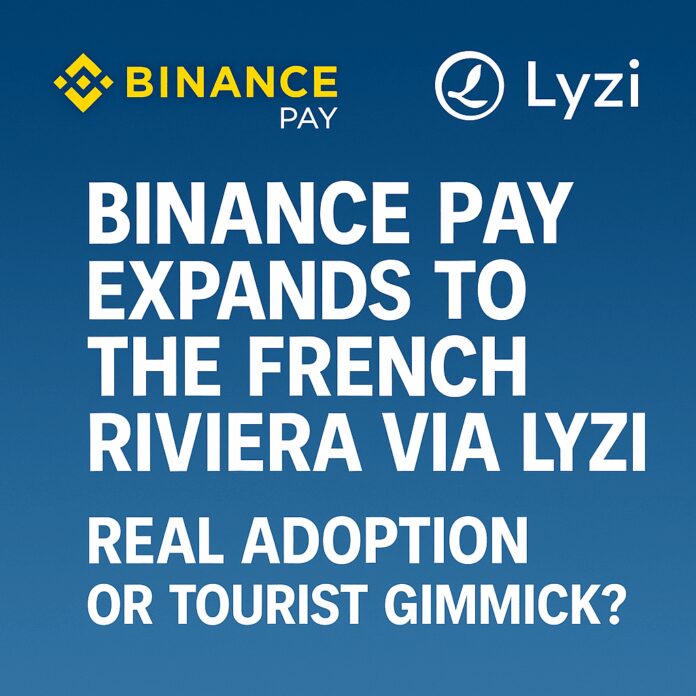Crypto payments arrive at the Côte d’Azur, but can they outlast the summer?
The pitch: Spend crypto in Saint-Tropez
Binance Pay, the crypto payment arm of global exchange Binance, has partnered with French Web3 payment startup Lyzito enable crypto spending across over 150 merchants in the French Riviera.
According to Cointelegraph, the integration covers restaurants, luxury boutiques, local attractions, and more in high-traffic destinations like Nice, Cannes, Antibes, and Saint-Tropez.
Users can now pay with over 70 cryptocurrencies, including Bitcoin (BTC), BNB, USDT, and Ethereum (ETH), via Binance Pay and Lyzi’s merchant-facing PoS solution.
What’s the goal?
| Objective | Explanation |
|---|---|
| Mainstream crypto usage | Shift crypto from trading to daily spending—especially in travel hotspots. |
| Merchant onboarding | Lyzi aims to give merchants euro settlement, avoiding volatility risks. |
| Tourism leverage | Capitalize on crypto-friendly international visitors in one of Europe’s most glamorous regions. |
This isn’t Binance’s first rodeo. Binance Pay has previously launched with Al-Futtaim in the UAE and CityPay in Georgia, but France represents a strategic EU beachhead—both figuratively and literally.
Strategic significance: Why France, and why now?
France is one of the few EU countries where Binance holds a PSAN license from the AMF, giving it regulatory breathing room.
The rollout coincides with the tourist season, tapping into affluent crypto holders on vacation.
Lyzi is part of a wave of compliance-forward French fintechs, positioning themselves as Web3-native payment rails.
It’s also a subtle play to regain credibility in Europe, after Binance faced setbacks in Germany, the UK, and the Netherlands.
But real-world crypto payments still face big hurdles
1. Merchant demand is limited
Despite the splashy rollout, actual merchant demand for crypto payments remains low. Most shops see little reason to complicate checkout flows when credit cards dominate.
2. Consumer friction
Paying with crypto involves network fees, confirmations, exchange rates, and tax headaches. In-store use still feels clunky compared to NFC tap-to-pay.
3. Regulatory risk remains
Even with AMF registration, Binance continues to face ongoing scrutiny in France and beyond. Regulatory changes under MiCA or ESMA could alter how crypto payment services operate in the EU.
4. Volatility and settlement lags
Stablecoins like USDT reduce price risk, but most merchants still prefer instant euro settlement—making the crypto part invisible to end-users.
Is it real adoption or just a marketing splash?
Crypto payments in luxury coastal towns are symbolically powerful, but it’s unclear if they represent true demand or temporary novelty.
Crypto-native tourists may use it once for the experience—but is that enough to create sustainable adoption?
Like past efforts in Portofino, Dubai, or Miami, these launches often serve PR purposes more than building enduring ecosystems.
Bottom line
The Binance Pay–Lyzi rollout is a bold signal: crypto payments are alive, regulated, and targeting real-world use—not just yield farming.
But for this to go beyond vacation-season marketing, it will require:
- Persistent merchant incentives
- Stable regulatory footing
- UX on par with traditional payment rails
Until then, crypto might buy you a croissant in Cannes, but Visa still runs the Riviera.



